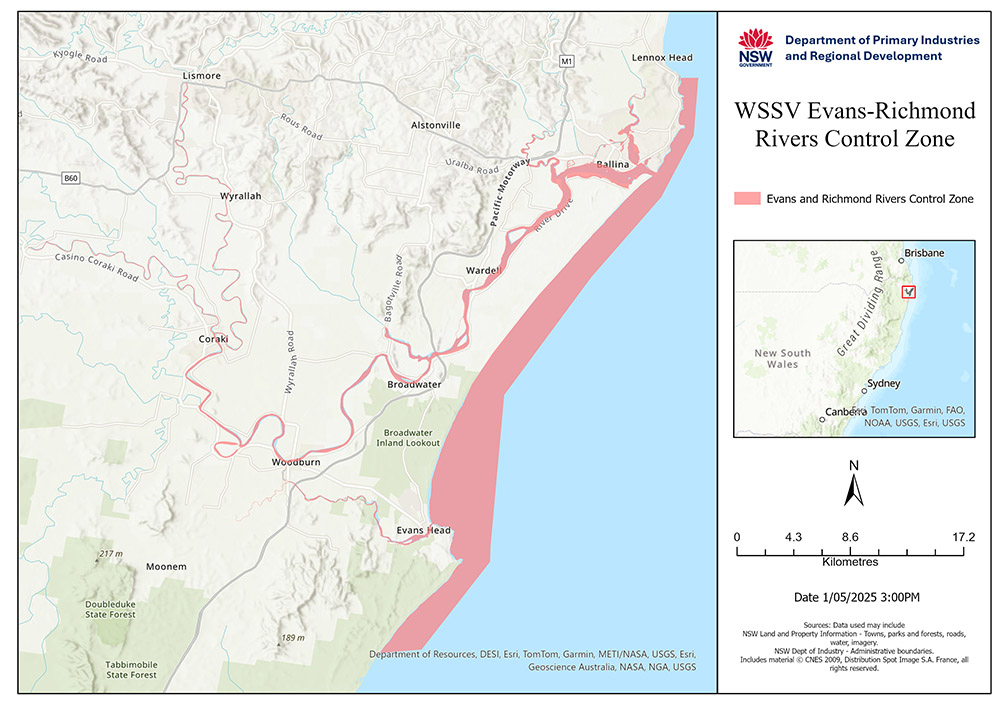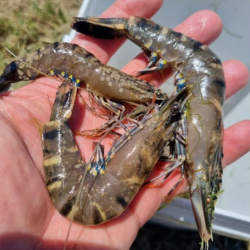White spot syndrome virus causes white spot disease, which is a highly contagious disease of decapod crustaceans.
These include prawns, crabs, yabbies and lobsters.
Polychaete worms used as bait that are sourced from areas affected by white spot disease can potentially carry the disease.
White spot syndrome virus (WSSV) and white spot disease (WSD) are not a threat to human health or food safety.
Detection in Australia
Since May 2024, the NSW Department of Primary Industries and Regional Development (NSW DPIRD) has been responding to white spot syndrome virus (WSSV) in wild-caught school prawns.
Detections of WSSV have occurred during surveillance of the Clarence River Control Zone, which was established following a WSD outbreak on prawn farms in February 2023.
In April 2025, prawn samples from marine waters offshore from Yamba, near the Clarence River, were confirmed positive for WSSV by the CSIRO’s Australian Centre for Disease Preparedness (CSIRO’s ACDP).
An existing biosecurity control order has been amended to extend the biosecurity zone approximately 6 km north of the Clarence River.
Samples from areas adjacent to the Evans and Richmond rivers also tested positive for WSSV.
Restrictions on the movement of prawns, other crustaceans and certain polychaete wormsare in place to prevent the human mediated spread of the virus from the existing control zones in northern NSW.
NSW movement restrictions
NSW DPIRD has implemented WSSV control zones covering the areas where WSSV has been detected and is working closely with affected stakeholders.
Meetings of the national Aquatic Consultative Committee on Emergency Animal Diseases (AqCCEAD) have been held to provide coordinated national technical discussion to assist with the NSW response.
More information on the NSW response.
Check your state or territory’s movement and import requirements before moving seafood products across jurisdictional borders.
Evans and Richmond Rivers Control Zone

Clarence River Control Zone

Testing and surveillance
Testing of samples was conducted by the NSW DPIRD Elizabeth Macarthur Agricultural Institute and the positive results were confirmed by CSIRO’s ACDP.
CSIRO’s ACDP has also completed genetic testing on positive samples from each of the control zones (inshore areas of both zones) and determined that the strain of WSSV is consistent with the strains previously detected in northern NSW:
- at a Clarence River prawn hatchery in 2022
- the white spot disease (WSD) outbreak at Clarence River prawn farms in 2023
- the WSSV detection adjacent to Evans River in 2024.
About WSSV and WSD
White spot disease (WSD) is caused by white spot syndrome virus (WSSV). WSD is a highly contagious viral disease of crustaceans, including prawns, lobsters and crabs.
Marine polychaete worms (including beach worms) are also considered to be vectors of the disease.
Finfish are not affected by the disease and are not carriers.
White spot in aquarium fish is a parasitic skin infection and not related to white spot disease of crustaceans.
White spot disease is widespread throughout prawn farming regions in Asia and the Americas where it has caused severe losses on prawn farms.
There are three movement regulated areas for WSSV in Australia (the SE Qld Movement Regulated Area, the Clarence River Control Zone and the Evans and Richmond Rivers Control Zone).
Disease signs

Courtesy: NSW DPIRD
Signs of WSD are:
- the rapid onset of mortalities
- lethargy or unusual swimming behaviour
- cessation of feeding
- aggregations of sick or dead prawns near the water surface at the edge of rearing ponds or tanks of farmed prawns
- white spots on the carapace.
Visit outbreak.gov.au for information on how to prevent and identify white spot in farmed prawns.
Your obligations
You can help prevent the spread of WSSV and WSD.
Report sightings
Report anything unusual, even if you’re not sure.
If you suspect disease on your farm, call the Emergency Animal Disease Hotline on 1800 675 888. You’ll be directed to your state or territory government.
Recreational and commercial fishers
Steps to keep your favourite fishing spot disease free:
- Do not use seafood meant for human consumption as bait.
- Use local and reputable bait shops or source your own bait from local waterways.
- Put all unwanted seafood in a rubbish bin, not in the ocean or waterways.
- Keep your fishing gear, boat and trailer clean. Make sure that you remove bait, debris and seaweed. Check, clean and dry wheel arches on trailers, boat propellers, fishing tackle and footwear.
- Use soapy water to clean your boat and trailer, fishing rods and other equipment. Allow them to dry completely before using them at another location, even if it is on the same day.
Import conditions for prawns
We monitor and enforce stringent import conditions to manage the biosecurity risk associated with imported prawns and safeguard our valuable fisheries and aquaculture industries.
Measures to ensure Australia's import conditions are being met include pre-border and border disease testing, retail testing, and working with exporting countries.
The final report for the Review of the biosecurity risks of prawns imported from all countries for human consumption was released on 5 June 2023.
Further information about the prawn review.
Resources
See more on the response and how you can manage the risk of white spot disease.
- White spot disease response in NSW (NSW DPIRD)
- White spot disease movement restrictions in Queensland (Qld DAF)
- White spot disease information guide PDF (Qld DAF)
- How to develop your aquaculture farm biosecurity plan (agriculture.gov.au)
- What you can do to Protect Australia's Aquatic Animal Health (agriculture.gov.au)
- Aquatic Biosecurity (NSW DPIRD)
- White spot disease movement restrictions video with Scott Hillier (Biosecurity Queensland)
- Biosecurity Basics (Marine pests website)